Study of the Phase Composition, Structure and Mechanical Properties of Synthetic Composites Produced by High-Temperature Vacuum Sintering of SHS-Fabricated CrNi-TiN Powders
Abstract
:1. Introduction
2. Materials and Methods
2.1. Preparation of the Initial Powder Mixture and Implementation of Self-Propagating High-Temperature Synthesis Processes
2.2. Preparing Composites by High-Temperature Vacuum Sintering of Fine-Ground SHS Products
2.3. Characterization
3. Results and Discussion
3.1. Investigation of the Processes of Self-Propagating High-Temperature Synthesis in NiTi–CrN Powder Mixture
3.2. Structure and Phase Composition of Products Obtained by Self-Propagating High-Temperature Synthesis from the NiCr–TiN Powder Mixture
3.3. Phase Composition and Structure of Materials Fabricated by High-Temperature Vacuum Sintering of Fine-Ground SHS-Fabricated CrNi–TiN Products
3.4. Investigation of the Mechanical Properties of Materials Fabricated by the High-Temperature Vacuum Sintering of Fine-Ground SHS-Fabricated CrNi–TiN Composites
4. Conclusions
Author Contributions
Funding
Data Availability Statement
Conflicts of Interest
References
- Joost, W.L. Reducing vehicle weight and improving US energy efficiency using integrated computational materials engineering. JOM 2012, 64, 1031–1038. [Google Scholar] [CrossRef]
- Schubert, E.; Klassen, M.; Zerner, I.; Walz, C.; Sepold, G. Light-weight structures produced by laser beam joining for future applications in automobile and aerospace industry. J. Mater. Process. Technol. 2001, 115, 2–8. [Google Scholar] [CrossRef]
- Leqeu, P.; Lassince, P.; Warner, T.; Raynaud, G.M. Engineering for the future: Weight saving and cost reduction initiatives. Aircr. Eng. Aerosp. Technol. 2001, 73, 147–159. [Google Scholar] [CrossRef]
- Cao, W.; Mecrow, B.C.; Atkinson, G.J.; Bennett, J.W.; Atkinson, D.J. Overview of electric motor technologies used for more electric aircraft (MEA). IEEE Trans. Ind. Electron. 2001, 59, 3523–3531. [Google Scholar]
- Pushp, P.; Dasharath, S.M.; Arati, C. Classification and applications of titanium and its alloys. Mater. Today Proc. 2022, 54, 537–542. [Google Scholar] [CrossRef]
- Chen, H.; Chen, Z.; Cui, Y.; Wang, L.; Wang, M.; Liu, J.; Zhong, S.; Wang, H. The effect of TiB2 ceramic particles on Portevin–Le Chatelier behavior of TiB2/AlMg metal matrix composites. J. Mater. Res. Technol. 2021, 14, 2302–2311. [Google Scholar] [CrossRef]
- Prikhodko, S.V.; Savvakin, D.G.; Markovsky, P.E.; Stasuk, O.O.; Penney, J.; Enzinger, N.; Gaskill, N.; Deley, F. Friction welding of conventional Ti-6Al-4V alloy with a Ti-6Al-4V based metal matrix composite reinforced by TiC. Weld. World 2021, 65, 415–428. [Google Scholar] [CrossRef]
- Senthil, S.; Raguraman, M.; Manalan, D.T. Manufacturing processes & recent applications of aluminium metal matrix composite materials: A review. Mater. Today Proc. 2021, 45, 5934–5938. [Google Scholar]
- Qin, Y.Q.; Tian, Y.; Peng, Y.Q.; Luo, L.M.; Zan, X.; Xu, Q.; Wu, Y.C. Research status and development trend of preparation technology of ceramic particle dispersion strengthened copper-matrix composites. J. Alloys Compd. 2020, 848, 156475. [Google Scholar] [CrossRef]
- Groza, J.R.; Gibeling, J.C. Principles of particle selection for dispersion-strengthened copper. Mater. Sci. Eng. A 1993, 171, 115–125. [Google Scholar] [CrossRef]
- Hasegawa, T.; Miura, T.; Takahashi, T.; Yakou, T. Strengthening mechanisms in aluminum-ceramic particle composite alloys produced by mechanical alloying. ISIJ Int. 1992, 32, 902–908. [Google Scholar] [CrossRef]
- Fan, X.; Xu, L.; Wei, S.; Yao, L.; Sun, T.; Zhou, Y.; Pan, K.; Xiao, F.; Sun, K. Mechanical properties and strengthening mechanism of the hydrothermal synthesis of nano-sized α-Al2O3 ceramic particle reinforced molybdenum alloy. Ceram. Int. 2020, 46, 10400–10408. [Google Scholar] [CrossRef]
- Chawla, K.K. Metal matrix composites. In Composite Materials, 2nd ed.; Chawla, K.K., Ed.; Springer: New York, NY, USA, 1998. [Google Scholar]
- Chechi, P.; Maurya, S.K.; Prasad, R.; Manna, A. Microstructural and mechanical characterization of stir cast Al-SiC/Flyash/Graphite hybrid metal matrix composite. Mater. Today Proc. 2022, 64, 637–642. [Google Scholar] [CrossRef]
- Durlu, N. Titanium carbide based composites for high temperature applications. J. Eur. Ceram. Soc. 1999, 19, 2415–2419. [Google Scholar] [CrossRef]
- Graboś, A.; Huebner, J.; Rutkowski, P.; Zhang, S.; Kuo, Y.-L.; Kata, D.; Hayashi, S. Microstructure and Hardness of Spark Plasma Sintered Inconel 625-NbC Composites for High-Temperature Applications. Materials 2021, 14, 4606. [Google Scholar] [CrossRef]
- Promakhov, V.; Matveev, A.; Schulz, N.; Grigoriev, M.; Olisov, A.; Vorozhtsov, A.; Zhukov, A.; Klimenko, V. High-Temperature Synthesis of Metal–Matrix Composites (Ni-Ti)-TiB2. Appl. Sci. 2021, 11, 2426. [Google Scholar] [CrossRef]
- Promakhov, V.; Matveev, A.; Schulz, N.; Dronov, P.; Zhukov, A.; Vorozhtsov, A. Structure, Properties and Phase Composition of Composite Materials Based on the System NiTi-TiB2. Materials 2022, 15, 5327. [Google Scholar] [CrossRef]
- Benafan, O.; Bigelow, G.S.; Scheiman, D.A. Transformation behavior in NiTi-20Hf shape memory alloys–Transformation temperatures and hardness. Scr. Mater. 2018, 146, 251–254. [Google Scholar] [CrossRef]
- Yan, C.; Zeng, Q.; He, W.; Zhu, J. Enhanced surface hardness and tribocorrosion performance of 60NiTi by boron ion implantation and post-annealing. Tribol. Int. 2021, 155, 106816. [Google Scholar] [CrossRef]
- Xiao, F.; Xu, L.; Zhou, Y.; Pan, K.; Li, J.; Liu, W.; Wei, S. A hybrid microstructure design strategy achieving W-ZrO2(Y) alloy with high compressive strength and critical failure strain. J. Alloys Compd. 2017, 708, 202–212. [Google Scholar] [CrossRef]
- Matveev, A.; Promakhov, V.; Schultz, N.; Vorozhtsov, A. Synthesis of Metal Matrix Composites Based on CrxNiy-TiN for Additive Technology. Materials 2021, 14, 5914. [Google Scholar] [CrossRef]
- Maslov, V.M.; Borovinskaya, I.P.; Merzhanov, A.G. Problem of the mechanism of gasless combustion. Combust. Explos. Shock Waves 1976, 12, 631–636. [Google Scholar] [CrossRef]
- Ladd, M.; Palmer, R. Structure Determination by X-ray Crystallography, 5th ed.; Springer: New York, NY, USA, 2013. [Google Scholar]
- Rietveld, H.M. Line profiles of neutron powder-diffraction peaks for structure refinement. Acta Crystallogr. 1967, 22, 151–152. [Google Scholar] [CrossRef]
- Borovinskaya, I.P.; Merzhanov, A.G.; Novikov, N.P.; Filonenko, A.K. Gasless combustion of mixtures of powdered transition metals with boron. Combust. Explos. Shock Waves 1974, 10, 2–10. [Google Scholar] [CrossRef]
- Newport, A.; Carmalt, C.J.; Parkin, I.P.; O’Neill, S.A. The dual source APCVD of titanium nitride thin films from reaction of hexamethyldisilazane and titanium tetrachloride. J. Mater. Chem. 2002, 12, 1906–1909. [Google Scholar] [CrossRef]
- Samsonov, G.V. Nitrides; Naukova Dumka: Kiev, Ukraine, 1969. [Google Scholar]
- Khoshkhoo, M.S.; Scudino, S.; Thomas, J.; Surreddi, K.B.; Eckert, J. Grain and crystallite size evaluation of cryomilled pure copper. J. Alloys Compd. 2011, 509, 343–347. [Google Scholar] [CrossRef]
- Sedoi, V.S.; Ivanov, Y.F. Particles and crystallites under electrical explosion of wires. Nanotechnology 2008, 19, 145710. [Google Scholar] [CrossRef] [PubMed]
- Rempel, A.A.; Kozhevnikova, N.S.; Leenaers, A.J.G.; van den Berghe, S. Towards particle size regulation of chemically deposited lead sulfide (PbS). J. Cryst. Growth 2005, 280, 300–308. [Google Scholar] [CrossRef]
- Evtushenko, E.; Zemlianov, A.; Balokhonov, R. Microstructure-based numerical simulation of reversible phase transformations in metal-matrix composites. AIP Conf. Proc. 2022, 2509, 020069. [Google Scholar]
- Xu, L.; Sun, T.; Zhou, Y.; Xiao, F.; Zhang, M.; Wei, S. Evaluating compressive property and hot deformation behavior of molybdenum alloy reinforced by nanoscale zirconia particles. J. Alloys Compd. 2021, 860, 158289. [Google Scholar] [CrossRef]
- Farges, G.; Degout, D. Interpretation of the indentation size effect in vickers microhardness measurements-absolute hardness of materials. Thin Solid Film. 1989, 181, 365–374. [Google Scholar] [CrossRef]
- Hasegawa, H.; Kimura, A.; Suzuki, T. Microhardness and structural analysis of (Ti, Al) N, (Ti, Cr) N, (Ti, Zr) N and (Ti, V) N films. J. Vac. Sci. Technol. A Vac. Surf. Film. 2000, 18, 1038–1040. [Google Scholar] [CrossRef]
- Junhua, X.; Geyang, L.; Mingyuan, G. The microstructure and mechanical properties of TaN/TiN and TaWN/TiN superlattice films. Thin Solid Film. 2000, 370, 45–49. [Google Scholar] [CrossRef]
- Braic, M.; Balaceanu, M.; Braic, V.; Vladescu, A.; Pavelescu, A.; Albulescu, M. Synthesis and characterization of TiN, TiAIN and TiN/TiAIN biocompatible coatings. Surf. Coat. Technol. 2005, 200, 1014–1017. [Google Scholar] [CrossRef]
- Devaraju, A.; Kumar, A.; Kotiveerachari, B. Influence of rotational speed and reinforcements on wear and mechanical properties of aluminum hybrid composites via friction stir processing. Mater. Des. 2013, 45, 576–585. [Google Scholar] [CrossRef]
- Calvo, A.; Schlueter, K.; Tejado, E.; Pintsuk, E.; Ordás, N.; Iturriza, I.; Neu, R.; Pastor, J.Y.; García-Rosales, C. Self-passivating tungsten alloys of the system W-Cr-Y for high temperature applications. Int. J. Refract. Met. Hard Mater. 2018, 73, 29–37. [Google Scholar] [CrossRef]
- Zhu, D.; Liu, L.; Wang, X.; Liu, Y.; Chen, Z.; Wei, Z. Microstructure and compression behavior of in-situ synthesized Ti2AlC reinforced Ti-48Al-2Cr alloy with carbon nanotubes addition. J. Alloys Compd. 2021, 862, 158646. [Google Scholar] [CrossRef]
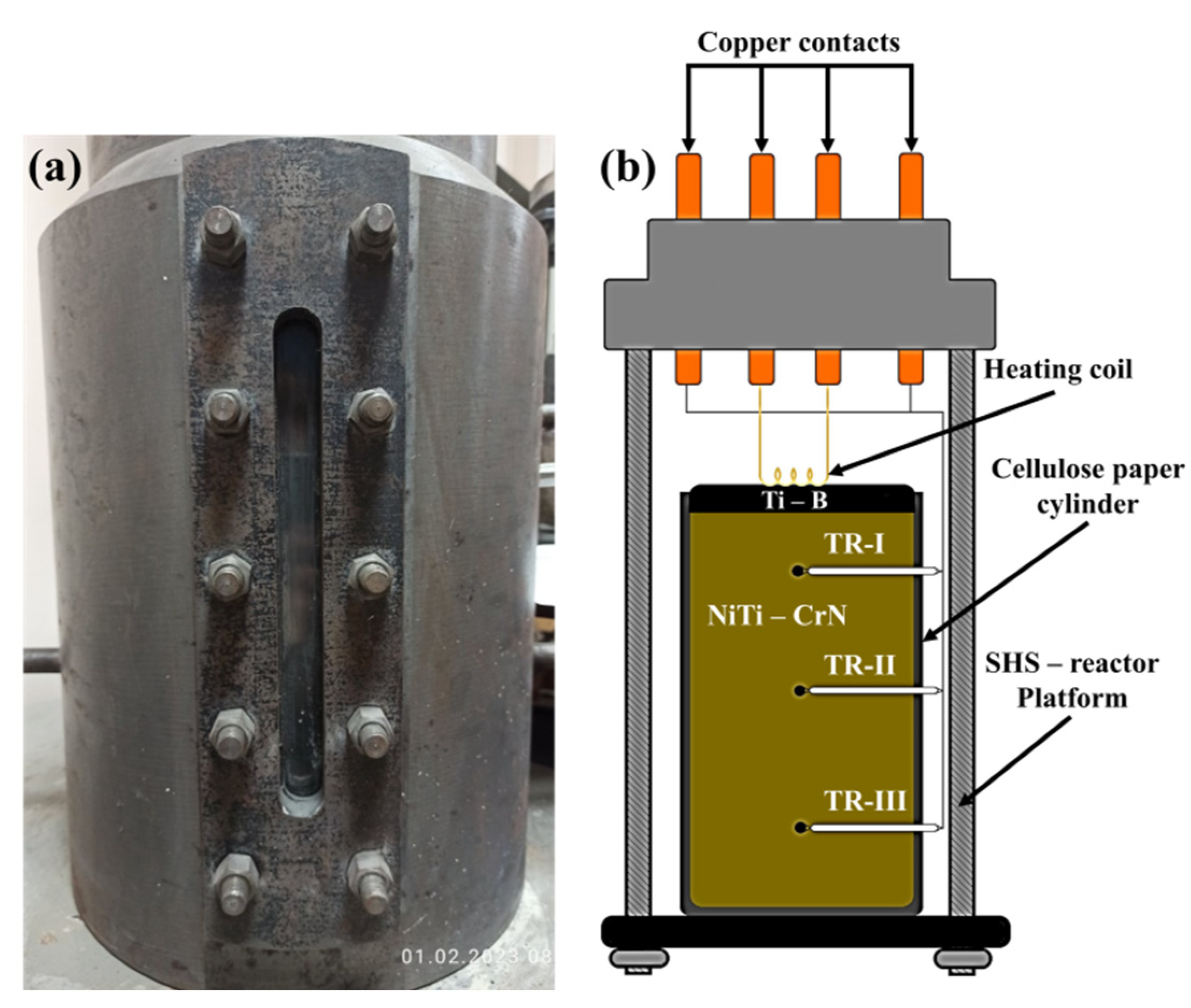
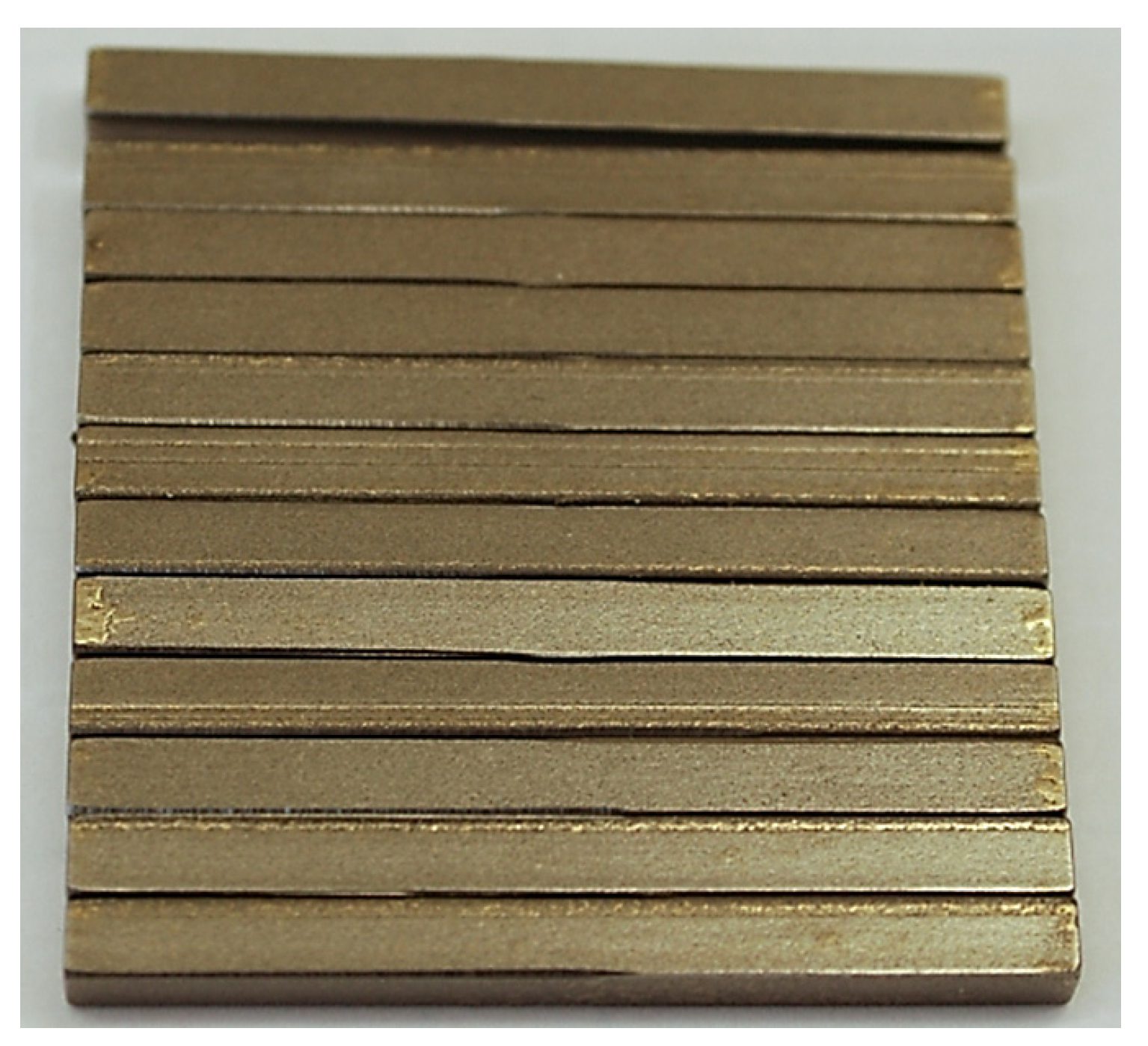
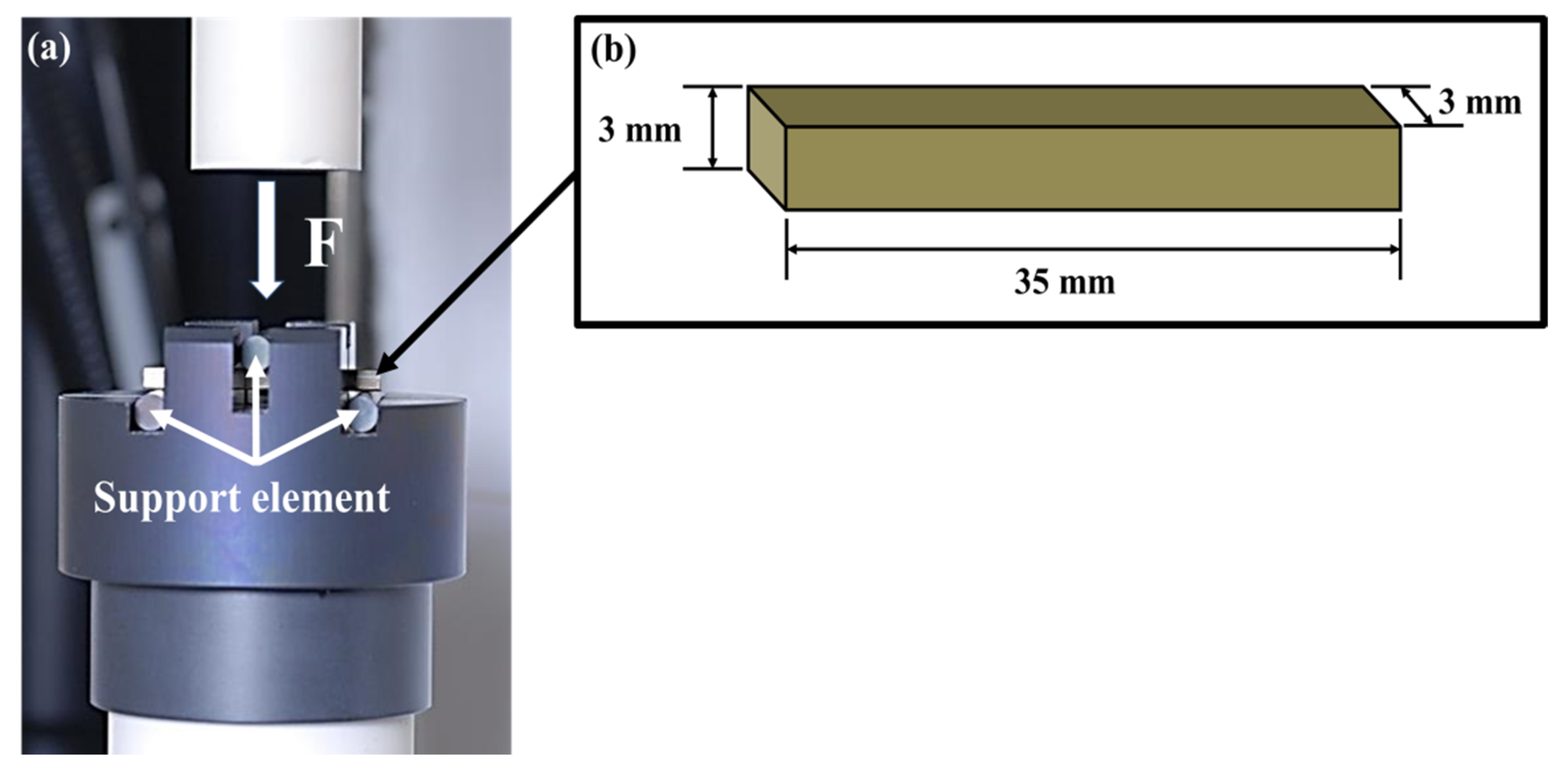

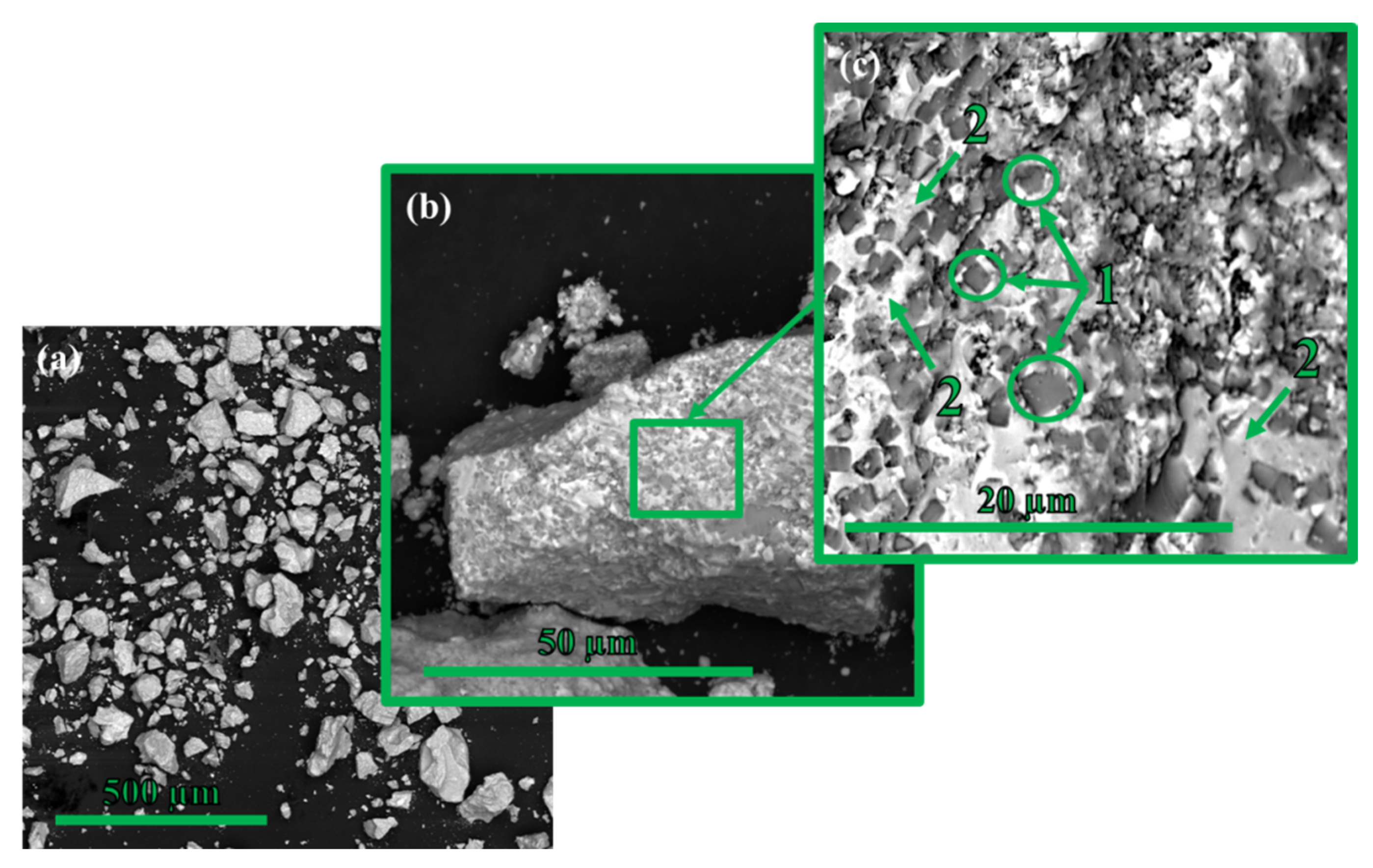

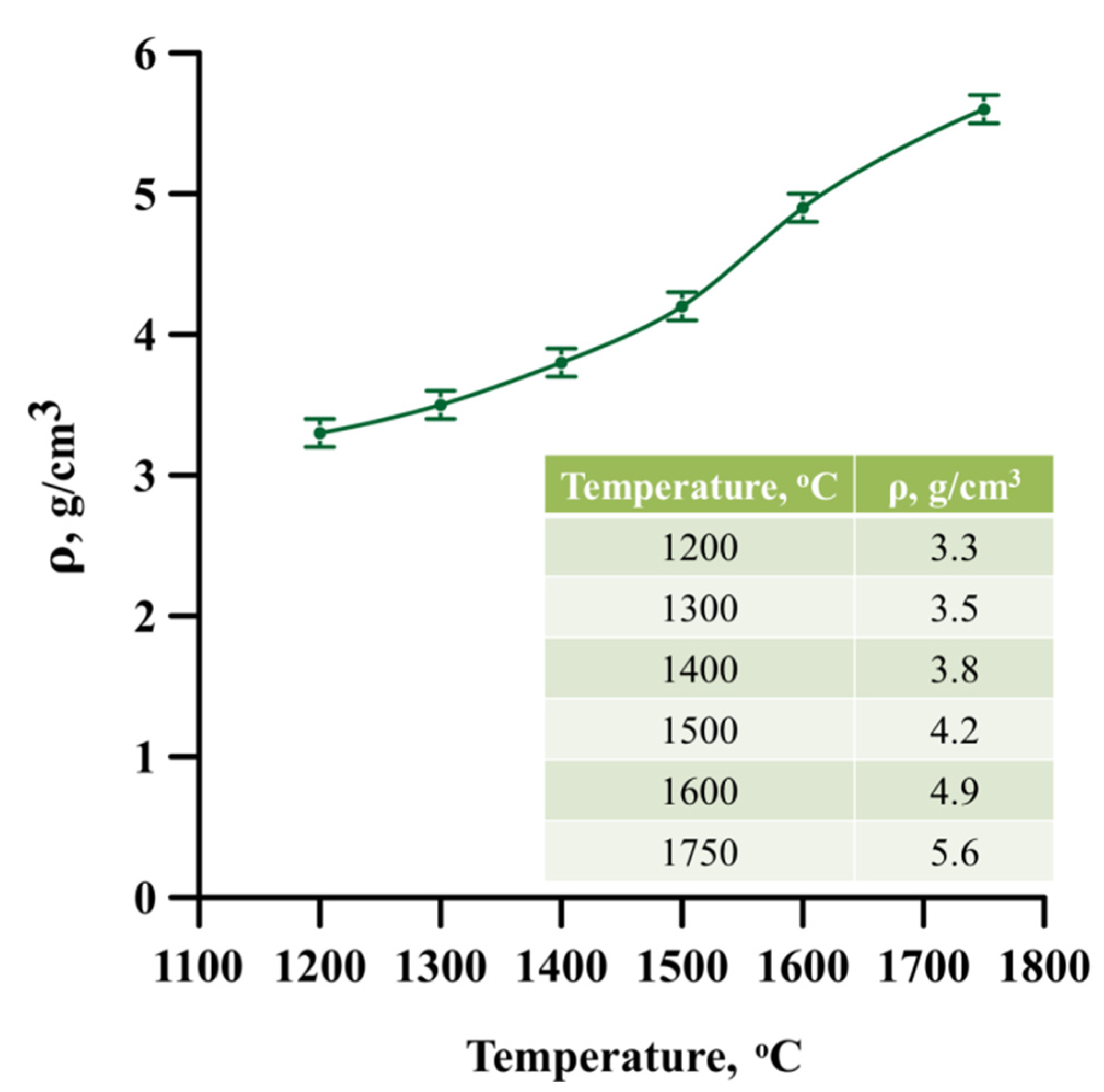
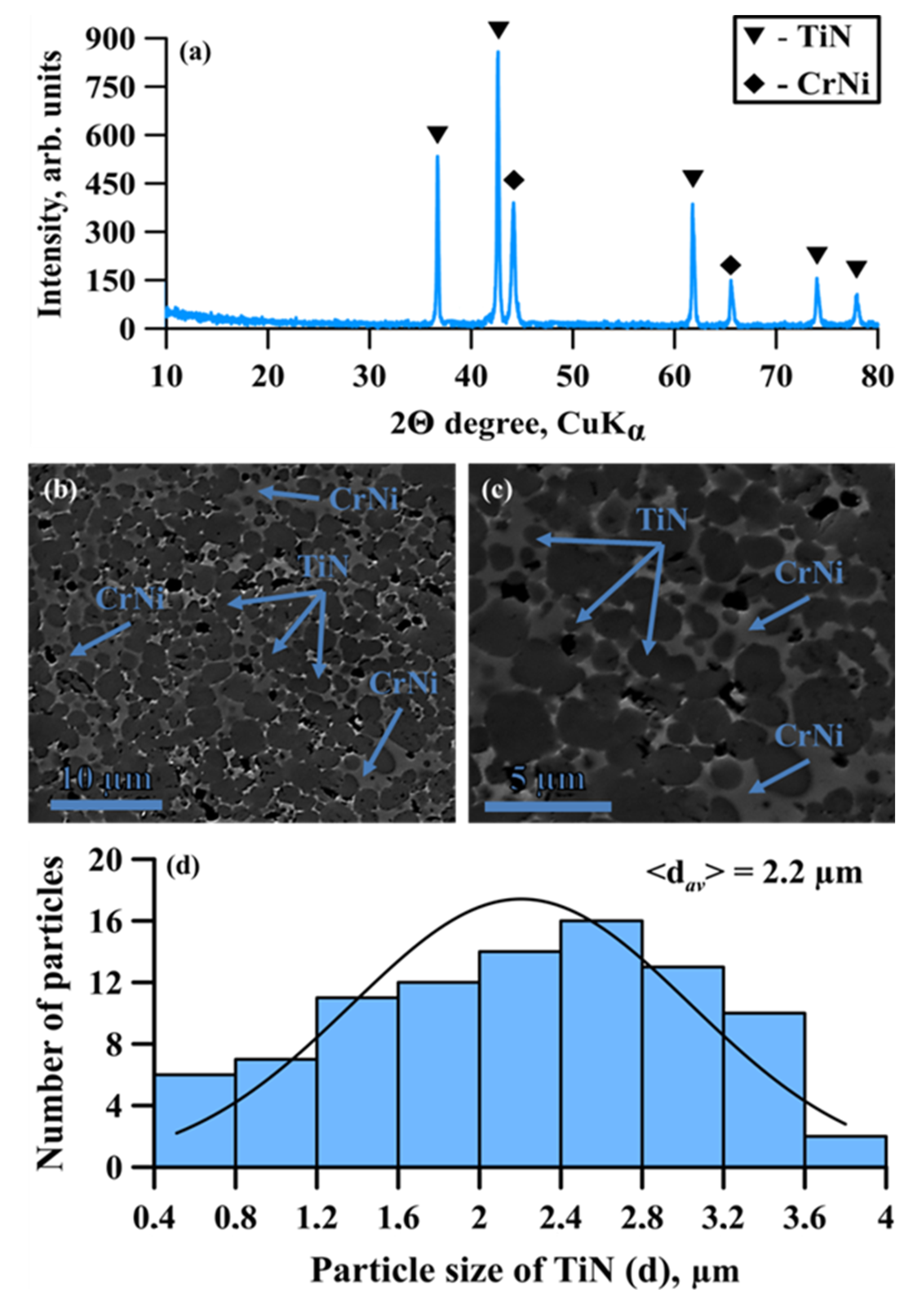
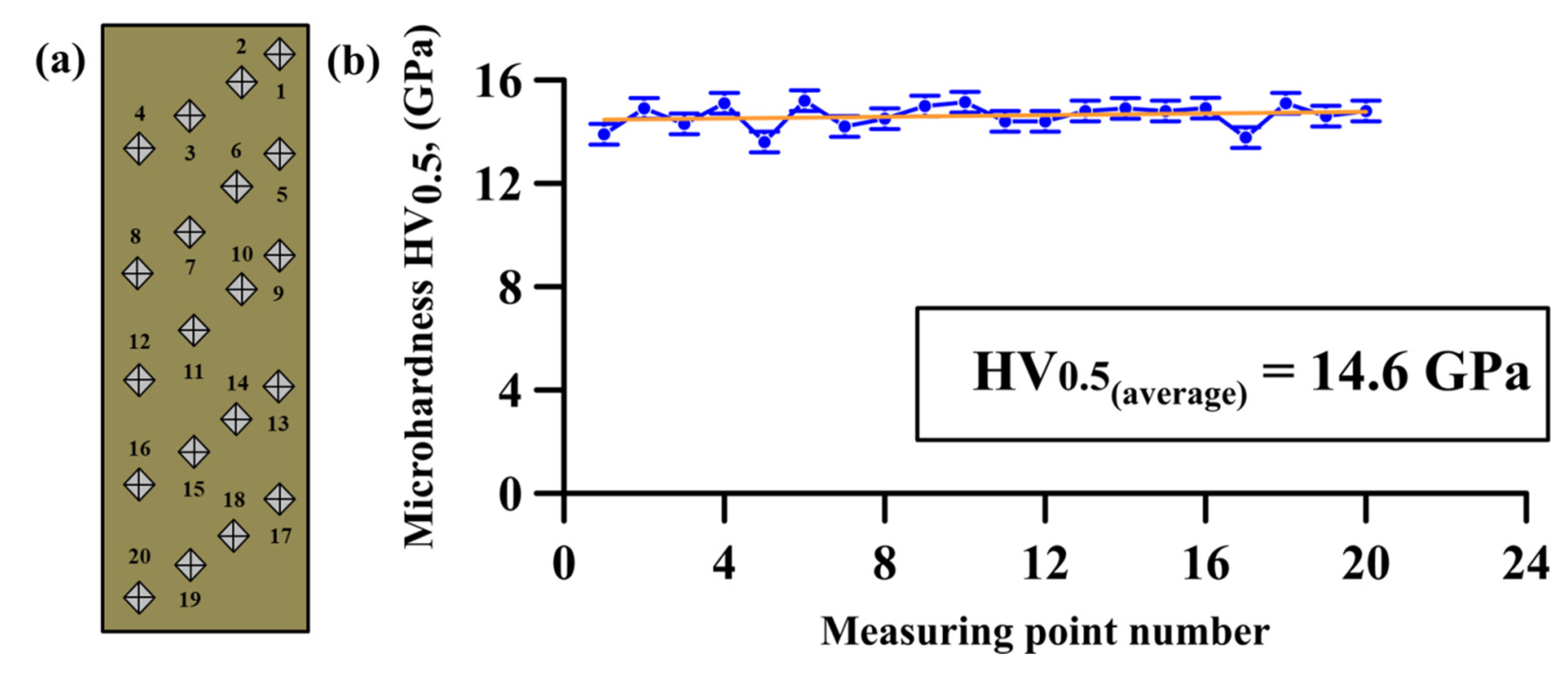
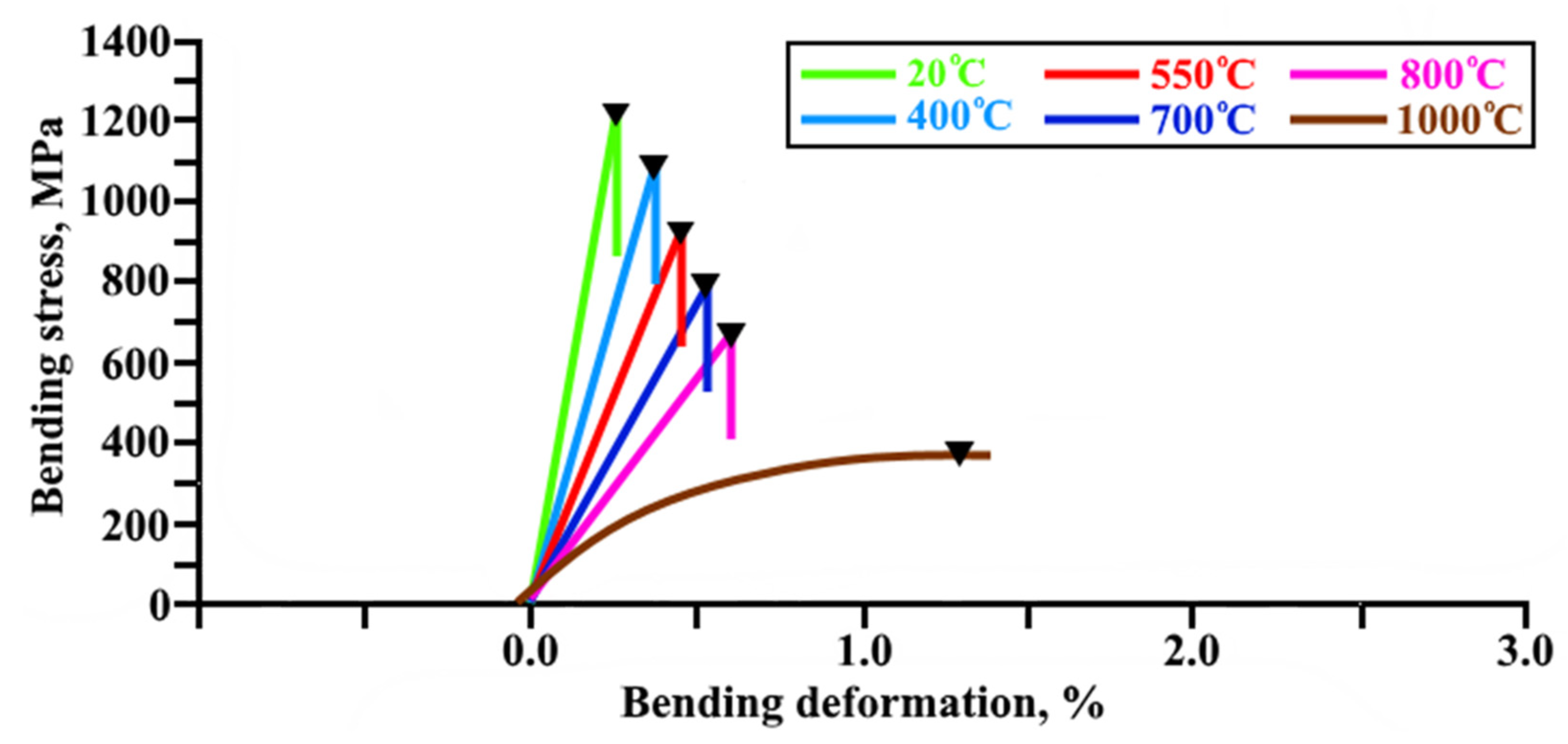
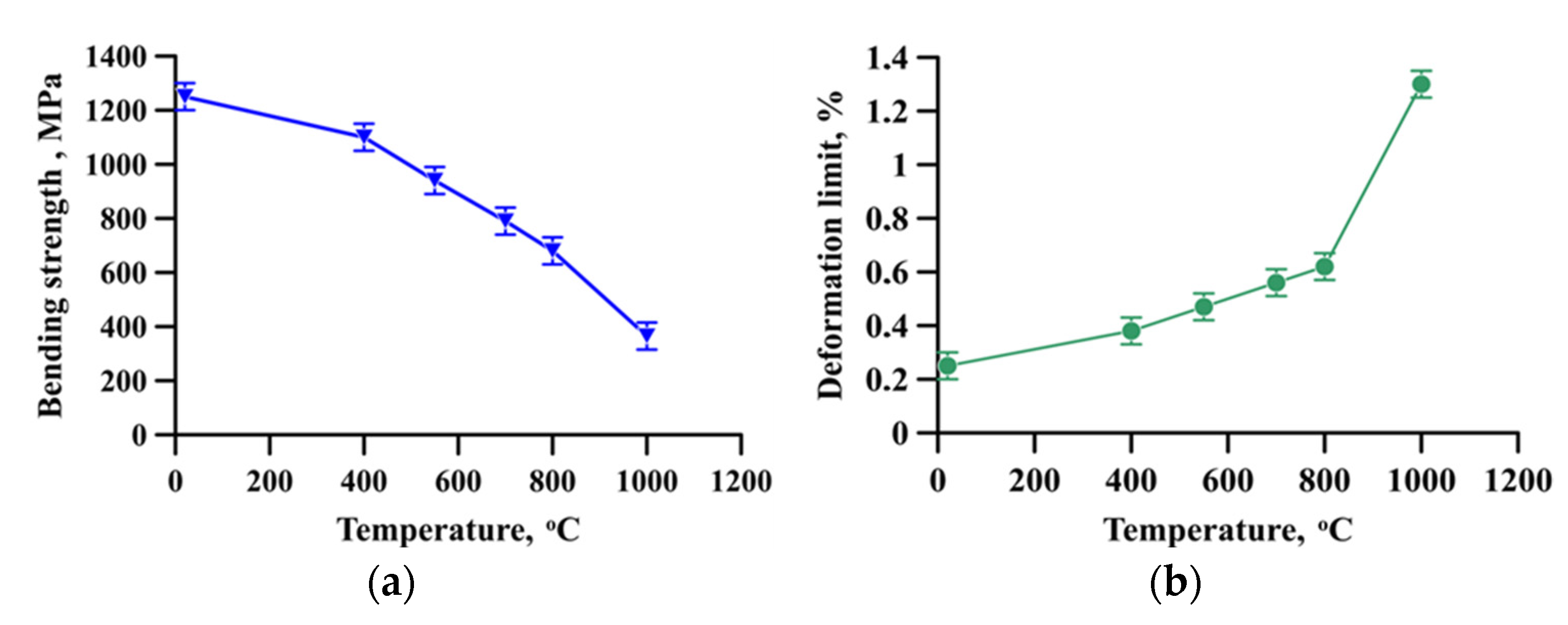
| Initial Powder | Manufacturer | Purity, % | Average Particle Size, µm |
|---|---|---|---|
| CrN | JSC Polema, Tula, Russia | ≥99.8 | 50 |
| TiNi | JSC Polema, Tula, Russia | ≥99.6 | 70 |
| Initial Mix Sample | Phases Found in SHS Products | Phase Composition, wt% | Lattice Parameters, Ǻ | CSR Size, nm |
|---|---|---|---|---|
| CrN-TiNi | TiN | 68 | a = 4.2387 | 51 |
| CrNi | 32 | a = 2.8851 | 49 |
| Initial Mix Sample | Phases Found in SHS Products | Phase Composition, wt% | Lattice Parameters, Ǻ | CSR Size, nm |
|---|---|---|---|---|
| CrN-TiNi | TiN | 71 | a = 4.2413 | 67 |
| CrNi | 29 | a = 2.8869 | 52 |
Disclaimer/Publisher’s Note: The statements, opinions and data contained in all publications are solely those of the individual author(s) and contributor(s) and not of MDPI and/or the editor(s). MDPI and/or the editor(s) disclaim responsibility for any injury to people or property resulting from any ideas, methods, instructions or products referred to in the content. |
© 2023 by the authors. Licensee MDPI, Basel, Switzerland. This article is an open access article distributed under the terms and conditions of the Creative Commons Attribution (CC BY) license (https://creativecommons.org/licenses/by/4.0/).
Share and Cite
Matveev, A.; Promakhov, V.; Schulz, N.; Bakhmat, V.; Babaev, A.; Vorozhtsov, A. Study of the Phase Composition, Structure and Mechanical Properties of Synthetic Composites Produced by High-Temperature Vacuum Sintering of SHS-Fabricated CrNi-TiN Powders. Metals 2023, 13, 846. https://doi.org/10.3390/met13050846
Matveev A, Promakhov V, Schulz N, Bakhmat V, Babaev A, Vorozhtsov A. Study of the Phase Composition, Structure and Mechanical Properties of Synthetic Composites Produced by High-Temperature Vacuum Sintering of SHS-Fabricated CrNi-TiN Powders. Metals. 2023; 13(5):846. https://doi.org/10.3390/met13050846
Chicago/Turabian StyleMatveev, Alexey, Vladimir Promakhov, Nikita Schulz, Vladislav Bakhmat, Artem Babaev, and Alexander Vorozhtsov. 2023. "Study of the Phase Composition, Structure and Mechanical Properties of Synthetic Composites Produced by High-Temperature Vacuum Sintering of SHS-Fabricated CrNi-TiN Powders" Metals 13, no. 5: 846. https://doi.org/10.3390/met13050846






